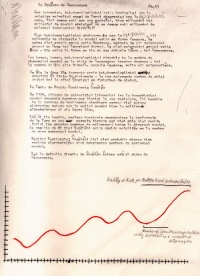Codex-6Bp1-English
From LostRing
(Difference between revisions)
| Revision as of 11:11, 5 April 2008 (edit) Limako (Talk | contribs) (another few paragraphs) ← Previous diff |
Revision as of 11:28, 5 April 2008 (edit) (undo) Limako (Talk | contribs) (first draft done) Next diff → |
||
| Line 5: | Line 5: | ||
| |language=English | |language=English | ||
| |need=translation | |need=translation | ||
| - | |translationby= | + | |translationby=limako |
| |translation= | |translation= | ||
| :The Danger of Neopangaea | :The Danger of Neopangaea | ||
| Line 16: | Line 16: | ||
| :<br> | :<br> | ||
| :Through time, however, whole-cosmologists noticed that the number of observed worlds in the state of Neopangaea was growing dramatically -- and the number of all other forms, except Pangaea, was much reduced. | :Through time, however, whole-cosmologists noticed that the number of observed worlds in the state of Neopangaea was growing dramatically -- and the number of all other forms, except Pangaea, was much reduced. | ||
| + | :<br> | ||
| + | :Not until the early 18th century could whole-cosmologists explain these two mysteries -- the very small number of possible states and the frequent changes among the distribution of states. | ||
| + | :<br> | ||
| + | :The Theory of Rapid Continental Change | ||
| + | :<br> | ||
| + | :In 1726, an alliance of scientists working through coordinated worlds proposed a theory to clarify the six types. | ||
| + | :<br> | ||
| + | :They theorized that the normalization of continental structure served as a natural method of synchronization for the many worlds when the multiverse approached the Upper Limit. | ||
| + | :<br> | ||
| + | :According to this theory, reality constantly reorganizes the arrangement of the continents into six normal formations in order to as quickly as possible do away with very large numbers of differences among the various worlds. | ||
| + | :<br> | ||
| + | :The result of these changes is a rapid reduction in the number of total contemporaneous worlds. | ||
| + | :<br> | ||
| + | :Rapid continental change therefore most likely happens when reality approaches the maximum number of contemporaneous worlds. | ||
| + | :<br> | ||
| + | :And the default direction of change seems to be to the state of Neopangaea. | ||
| }}<br clear="all"> | }}<br clear="all"> | ||
Revision as of 11:28, 5 April 2008
English
- Chapter 13: The danger of Neo-Pangaea (1/2)
(translation by limako)
- The Danger of Neopangaea
- For centuries, whole-cosmologists were confused by the relatively few kinds of earths observed through the Omphalos network.
- Why should there be only 6 types among billions and billions of worlds? Why should there not be billions and billions of different continental formations?
- When whole-cosmologists made extended observations through the Omphalos, they discovered that the majority of the worlds were in the form of Pangaea. The second largest group were Gondwana, followed by smaller groups in Nuna and Kenorland forms. The smallest groups were Gaea -- which is the form in which we six current live -- and Neopangaea.
- Through time, however, whole-cosmologists noticed that the number of observed worlds in the state of Neopangaea was growing dramatically -- and the number of all other forms, except Pangaea, was much reduced.
- Not until the early 18th century could whole-cosmologists explain these two mysteries -- the very small number of possible states and the frequent changes among the distribution of states.
- The Theory of Rapid Continental Change
- In 1726, an alliance of scientists working through coordinated worlds proposed a theory to clarify the six types.
- They theorized that the normalization of continental structure served as a natural method of synchronization for the many worlds when the multiverse approached the Upper Limit.
- According to this theory, reality constantly reorganizes the arrangement of the continents into six normal formations in order to as quickly as possible do away with very large numbers of differences among the various worlds.
- The result of these changes is a rapid reduction in the number of total contemporaneous worlds.
- Rapid continental change therefore most likely happens when reality approaches the maximum number of contemporaneous worlds.
- And the default direction of change seems to be to the state of Neopangaea.

























